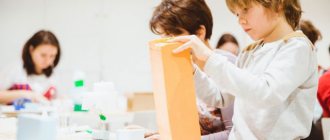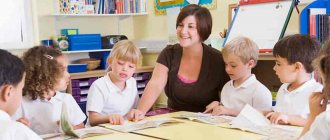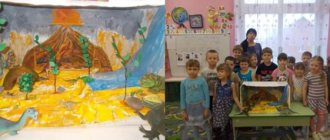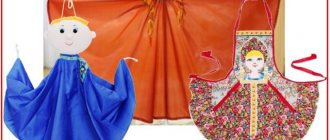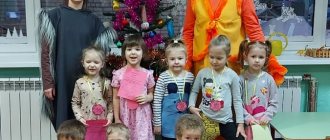A joint activity project with children and parents of the senior group “Vegetable garden on the window.”
MBDOU "CRR - Karagai kindergarten No. 4"
Project of joint activities with children and parents of the senior group
"Vegetable garden on the window."
Author: teacher Semenova T.A.
With. Karagay, 2021
Project type:
educational, creative.
Project participants:
Educator - Semenova Tatyana Arkadyevna, children of the senior group, parents.
Scale:
Short-term (3 weeks - from March 28 to April 20).
Relevance of the project:
It's no secret that preschool children are explorers by nature. An unquenchable thirst for new experiences, curiosity, a constant desire to experiment, to independently seek new information about the world, are traditionally considered as the most important features of children's behavior. Research and search activity is the natural state of a child; he is determined to understand the world. To explore, discover, study means to take a step into the unknown and unknown.
The topic of the developed project was chosen taking into account the age characteristics of children of senior preschool age and the amount of information that can be perceived by them. This children's research project is aimed at children gaining experience in their own experimental research activities, children becoming aware of their interests, developing the skills to realize them, and children acquiring and applying new knowledge in life. In the process of systematically caring for plants, certain work skills are formed in children; preschoolers are attentive to living nature and take care of plants.
Problem:
Is it possible to grow crops in a window in a group setting?
Preliminary work with children.
Speech development:
Thematic conversations “Why do plants need seeds?”, “When vegetables can help and when they can harm our health”, “Vegetables”, “Water and soil are vegetables’ best friends”;
Didactic games: “The fourth odd one”, “Wonderful bag”, “What first, what then?”, “Forbidden vegetable”.
Artistic and aesthetic development:
Reading and learning with children poems, riddles, sayings, songs about peas and cucumbers and onions; Reading fiction: Gianni Rodari “Cippolino”; Listening to the song “Vitamins” by Filippenko.
Drawing on the topic: “Cooking vegetable soup.” Modeling on the theme: “Onion”
Social and communicative development:
Role-playing games: “Shop”, “Vegetable Garden”, “We Are Helpers”;
Caring for the garden on the window (watering, loosening the soil).
Cognitive development:
Joint activity of parents, children, teachers - “Vegetable garden on the window”;
Planting dry seeds in the ground, examining dry seeds and germinated seeds through a magnifying glass, daily observations of seedlings;
Looking at books and illustrations about plants;
Organization of joint thematic projects in preschool educational institutions (teachers - children - parents)
Organizing full interaction between teachers, children and parents is one of the important tasks facing the staff of preschool institutions. In order for parents to become active assistants to teachers, it is necessary to involve them in the life of the kindergarten. One aspect of this issue is the search for rational ways of interaction. What is the interaction between teacher and parents? To accurately answer this question, we turned to S. Ozhegov’s Russian language dictionary, where the meaning of the word “interaction” is explained as the mutual connection of two phenomena, mutual support.
Both the family and the preschool institution convey social experience to the child in their own way. But only in combination with each other do they create optimal conditions for a little person to enter the big world. The path to dialogue between these two social institutions is complicated by the fact that there is an imbalance in the processes of education in the family and preschool educational institutions. Today, the potential capabilities of the family are undergoing a serious transformation. Teachers note a decrease in her educational potential and a change in her role in the process of primary socialization of the child. Modern parents have a hard time due to lack of time, employment, and lack of competence in matters of preschool pedagogy and psychology. Social instability, social tension, and economic pressure have moved the educational functions of the family to second and third places, and in preschool educational institutions, education always comes first. This situation can be leveled out by including the family in the educational space of the preschool educational institution.
One of these forms of cooperation and the inclusion of parents in the educational space of preschool educational institutions is the organization of joint thematic projects in kindergarten
“Project” (Latin) “thrown forward”, “protruding”, “conspicuous”.
A project is a specially organized set of actions that has a socially significant result.
The peculiarity of joint projects in kindergarten is that the child cannot yet independently formulate a problem or determine a plan, therefore, in the educational process of a preschool educational institution, project activities are in the nature of cooperation, in which children, teachers, and parents take part.
Working in joint projects gives:
- a child can learn to pose a problem, find solutions, plan, work independently with information, be a responsible partner, and respect the opinion of the interlocutor;
- a favorable atmosphere for learning is created in the group;
- a community of children, educators and parents is created;
- children have an incentive to work and learn with pleasure and desire;
- projects allow you to quickly obtain a clear result of your activities;
The organization of joint thematic projects can be considered as a special mechanism for interaction between families and preschool educational institutions.
A preschooler cannot be the author or leader of project activities. He needs the help of adults who can understand his interests. The main organizer of joint projects with parents is the teacher. He is a source of information, a consultant, an expert.
He is the main leader of the project and subsequent research, gaming, artistic, practice-oriented activities, coordinator and partner of children and parents in solving the problem.
Stages of work on the project:
1. Goal setting: the teacher helps the child choose the most relevant and feasible task for him for a certain period of time.
2. Project development - action plan to achieve the goal:
- who to turn to for help (an adult, a teacher);
- what sources can you find information in?
— what items to use (accessories, equipment);
— what objects to learn to work with to achieve the goal.
— GCD, games and other types of children’s activities
3. Project implementation – practical part (collecting and accumulating material, completing homework, project result)
4. Summing up – presentation and definition of tasks for new projects.
The project is the 5 Ps:
- problem;
- design or planning;
- search for information;
- product;
- presentation.
As the stages of the joint project are implemented, teachers and parents help the child find means and ways to achieve the goal.
Relying on the help of adults, children seek a solution to the problem through questions to their parents, joint trips to the library, reading educational literature, and observations. Together with their parents, they are engaged in productive activities: drawing, crafting, composing.
Thus, joint collection of materials, production of attributes, games, competitions, presentations reveal the creative abilities of children, involve parents in the educational process, which naturally affects the results. Parents, participating in the implementation of the project, are not only sources of information, real help and support for the child and teacher in the process of working on the project, but also become direct participants in the educational process, enrich their teaching experience, experience a sense of ownership and satisfaction from their successes and the achievements of their child. Parents can be not only a source of information, but also a source of real help and support for the child in the process of working on a project; they can enrich their teaching experience, experience a sense of ownership and satisfaction from their successes and the successes of the child.
By implementing the project method, we cultivate an independent and responsible personality, and develop the child’s mental and creative abilities. Joint projects broaden the horizons of children and adults, fill them with creative energy, and help build relationships and cooperation between family and kindergarten. It is project activities that will help unite teachers, children and parents, teach them to work in a team, collaborate, and plan their work. And most importantly, every child will be able to express themselves, feel needed, which means that self-confidence will appear and the child’s self-esteem will increase. By participating in the project, the child feels significant in a group of peers and sees his contribution to the common cause. One of the advantages of design technology is that each child is recognized as important and necessary in the team. He sees the results of efforts at the beginning of the group, and then the entire team. The child understands that other participants in the process notice his contribution to the common cause, and therefore strives to keep up with his peers.
Thus, the introduction of joint thematic projects into the educational process contributes to the development of a free creative personality, which corresponds to the social order at the present stage and makes the educational process of a preschool organization open to the active participation of parents and other family members.
Features of the implementation of the design method in preschool educational institutions
The project method can be represented as a way of organizing the educational process, based on the interaction between teacher and student, a way of interacting with the environment, and step-by-step practical activities to achieve a set goal.
The transfer of a preschool institution to a project-based method of activity is usually carried out in the following stages:
- Classes including problematic situations of children's experimentation, etc.;
- integrated topic block classes;
- integration: partial or complete;
- project method as a form of organizing educational space; as a method for developing creative cognitive thinking.
Work in this direction is implemented primarily through the training of teachers, educational work with parents, and the creation of a subject-spatial environment in accordance with the requirements of the design method.
The implementation of the above technology imposes certain requirements on the teacher as a creative person and special training to improve pedagogical professionalism, since a teacher who masters the project method as a technology and as an activity for co-creating a professional space can teach a child to design.
The teacher acts as an organizer of children's productive activities, as a source of information, as a consultant, as an expert. He is the main leader of the project and subsequent research, gaming, artistic, practical activities, the coordinator of individual and group efforts of children in solving the problem. Therefore, the introduction of the project method into practice begins with organizing work with the teaching staff. These can be the following methods and forms of work: seminars, consultations, joint viewing of lessons, simulation games, methodological exhibitions, master classes, conversations, debates, workshops, trainings, round tables, work with teaching materials, days of mutual visits, project presentations. Exemplary projects on working with human resources are presented in Appendix 2.
The main goal of introducing the project method in a preschool institution is the development of the child’s free creative personality, which is determined by the developmental goals and objectives of children’s research activities.
The goal is to determine learning goals, create learning conditions and research skills in accordance with the main lines of development. The project method gives the child the opportunity to:
- experiment, synthesize acquired knowledge;
- develop their creativity and communication skills, which allows them to successfully adapt to the changing learning situation at school.
The project method can be used in working with children not only of older, but also of younger preschool age. The objectives of research activities are specific for each age and make it possible to determine learning goals and create conditions for the formation of educational and research skills in accordance with the main lines of development.
To implement the project, the teacher determines the stages of implementation, thinks through the content of the activity and selects practical material. In this case, when planning project activities, the teacher must remember the three stages of development of project activities in preschoolers, which are one of the pedagogical technologies of project activities, including a set of research, search, problem-oriented, creative methods.
The first stage is imitation and performance, the implementation of which is possible in children aged 3.5-5 years. At this stage, children participate in the project “in a secondary role”, perform actions at the direct suggestion of an adult or through his imitation, which does not contradict the nature of a small child; at this age there is still a need to form and maintain a positive attitude towards an adult and imitate him.
Project “Joint creative activity of children and their parents in the educational process”
MUDO Center for Additional Education of Children in Avsyunino
Orekhovo-Zuevsky urban district, Moscow region
Project
“Joint creative activity of children and their parents
in the educational process"
The author of the project is a teacher of additional education
highest qualification category
Kuritsina Elena Konstantinovna
2020
“Joint creative activity of children and their parents
in the educational process"
The key task of modern state policy of the Russian Federation is to ensure the spiritual and moral development and education of the personality of a Russian citizen.
“Spiritual and moral development and education of the individual begins in the family. It is family values, acquired by a child from the first years of life, that are of lasting importance for a person at any age and form the basis of civil behavior in society.”
Parents play a vital role in a child's life. Parental love is the source and guarantee of human well-being, maintaining physical and mental health. That is why the first and main task of parents is to create confidence in the child that he is loved and cared for. Deep, constant psychological contact with parents gives the child the opportunity to feel and realize parental love, affection and care.
The basis for maintaining psychological contact is a sincere interest in everything that happens in a child’s life, sincere curiosity about his childhood, even the most trivial and naive, problems, a desire to understand, a desire to observe all the changes that occur in the soul and consciousness of a growing person. It is necessary to communicate with children from a young age: without communication, without constant concern for arranging common leisure time and common affairs with them, parents will not be interested in their own children.
The main values of educational activities in the system of additional education are the child, his development, childhood as the special life of a child, educational space as an environment conducive to personal development. Therefore, additional education has great potential to help parents establish and maintain psychological contact with the child, spiritual and moral development and education of all participants in the educational process.
One of the forms of interaction between additional education institutions and students’ families is family clubs and workshops. Organized joint creative activity is the inclusion of the parent in the child’s activity. This is a situation in which a child, faced with a certain difficulty, has the opportunity to turn to a parent for help. And the parent gets the opportunity to do the work together with the child. As a result of joint creative activity and common interests, the child and parent reach mutual understanding and become closer to each other.
